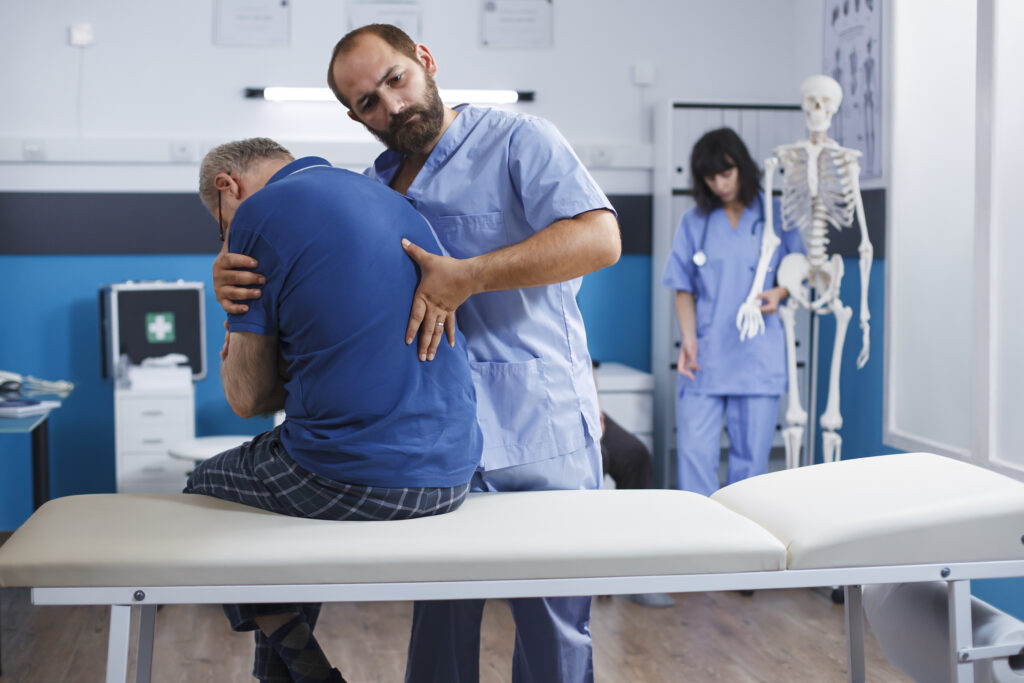Improving senior mobility can make a significant difference in daily life, allowing for greater independence and safety. You might not realize how simple adjustments, like modifying the home environment or incorporating assistive devices, can enhance mobility. Even low-impact exercises can play an important role in maintaining strength and flexibility. As you explore these effective strategies, consider how each adjustment can be tailored to individual needs. What specific changes could lead to a more active and fulfilling lifestyle for seniors? Let's consider the options together.
Importance of Mobility
Mobility is essential for maintaining independence and quality of life as we age. When you stay active and mobile, you enhance your physical health, mental well-being, and overall happiness. It's not just about moving from one place to another; it's about engaging with the world around you. Whether it's taking a walk in your neighborhood, participating in a favorite hobby, or visiting friends and family, mobility plays a vital role in fostering social connections and preventing feelings of isolation.
As you age, it's easy to underestimate the importance of staying mobile. You might notice some changes in your body, but it's important to keep pushing yourself to stay active. Regular movement helps maintain muscle strength, flexibility, and balance, which can greatly reduce the risk of falls and injuries.
Additionally, keeping active can boost your energy levels and improve your mood, making it easier to tackle daily tasks.
You don't have to engage in intense workouts to reap the benefits of mobility. Simple activities like stretching, walking, or gentle yoga can make a big difference.
Consider incorporating short walks into your routine or finding enjoyable activities that get you moving. Remember, every little bit counts. The key is to find what works best for you and stick with it.
Home Modifications for Safety
Making a few smart home modifications can greatly enhance safety and mobility for seniors. One of the simplest changes you can make is to remove tripping hazards. Start by clearing pathways of clutter, rugs, and electrical cords that could lead to falls. If you have carpets, make sure they're secured to the floor to prevent slipping.
Next, consider installing grab bars in key areas like the bathroom and hallways. These provide extra support when getting in and out of the shower or moving from room to room. Non-slip mats in the bathroom can also reduce the risk of accidents.
Improving lighting is another crucial modification. Replace dim bulbs with brighter LED lights, and make certain all areas of the home are well-lit. Motion-sensor lights can be particularly useful, illuminating paths automatically during the night.
Lowering shelves and rearranging frequently used items within easy reach can minimize the need for climbing or stretching, greatly reducing the risk of falls. Additionally, you might want to install a shower chair or a raised toilet seat, making daily routines safer and more comfortable.
Lastly, consider adding a few well-placed handrails on stairs, which can provide essential support.
Assistive Devices and Technology
When it comes to enhancing mobility, assistive devices and innovative technologies play an essential role.
You might discover various types of devices designed specifically to support your needs and improve your daily activities.
Let's explore how these tools can make a significant difference in your life.
Types of Assistive Devices
Independence is an essential aspect of maintaining a fulfilling life, especially for seniors as they navigate new physical challenges.
Assistive devices can play an important role in enhancing mobility and ensuring safety. By understanding the various types available, you can make informed choices that suit your needs.
Here are four common types of assistive devices you might consider:
- Walkers: These provide stability and support while walking, helping you maintain balance.
- Canes: Lightweight and portable, canes offer additional support and are useful for those who need a little extra help.
- Wheelchairs: For seniors with limited mobility, wheelchairs can enhance independence, allowing for easier movement indoors and outdoors.
- Grab Bars: Installing grab bars in bathrooms or stairways can provide essential support and prevent falls.
Innovative Mobility Technologies
Advancements in mobility technologies are transforming the way seniors experience movement and independence. You'll find innovative assistive devices designed to enhance mobility and make daily activities easier. For instance, smart walkers equipped with sensors can detect obstacles, helping you navigate safely.
These walkers often include features like GPS tracking, allowing family members to monitor your location for added peace of mind.
Another exciting development is the rise of powered wheelchairs and scooters. These devices are more lightweight and user-friendly than ever, enabling you to travel longer distances with ease. Some models even come with customizable controls and advanced steering systems, making them suitable for various mobility needs.
Additionally, wearable technology, like smart shoes or fitness trackers, can provide real-time health monitoring. These gadgets can alert you to potential falls or changes in activity levels, ensuring that you're always aware of your well-being.
Embracing these innovative mobility technologies not only helps you regain independence but also boosts your confidence and quality of life.
Exercise Recommendations
To keep moving with ease, you should consider incorporating low-impact activities into your routine.
These exercises, along with some strength training, can help boost your mobility and overall health.
Let's explore some effective options that fit your lifestyle.
Low-Impact Activities
Low-impact activities are essential for maintaining mobility and overall wellness in seniors.
These exercises help improve strength, flexibility, and balance while reducing the risk of injury. Incorporating low-impact activities into your routine can make a significant difference in your daily life.
Here are some great options to evaluate:
- Walking: A simple and effective way to stay active. Just a 20-30 minute walk can boost your mood and energy.
- Swimming or Water Aerobics: The buoyancy of water reduces strain on your joints while providing a full-body workout.
- Yoga: This practice enhances flexibility, balance, and relaxation. Plus, it can be easily adapted to your abilities.
- Tai Chi: Known for its slow and graceful movements, Tai Chi improves balance and coordination, making it a great choice for seniors.
Strength Training Exercises
Strength training exercises play an essential role in enhancing mobility and strength for seniors. Incorporating these exercises into your routine can help you maintain independence and perform daily activities with ease.
Start with body-weight exercises, like squats and wall push-ups. These movements build strength without added strain. You can also use light weights or resistance bands as you progress. Try seated rows with a resistance band or bicep curls with light dumbbells.
Aim for two to three sessions per week, focusing on major muscle groups. Remember to keep your movements slow and controlled to avoid injury.
Additionally, consider working on balance through strength training. Exercises like single-leg stands or heel-to-toe walking can help prevent falls. Always warm up before starting and cool down afterward to enhance flexibility and recovery.
Before starting any new exercise program, it's wise to consult with your doctor or a physical therapist. They can help tailor a program that meets your needs and abilities.
Stretching and Flexibility
Stretching and flexibility exercises play an essential role in enhancing mobility for seniors. These exercises help maintain and improve the range of motion in joints, reduce stiffness, and promote better posture. Incorporating regular stretching into your routine can greatly impact your daily activities, making it easier to move around and perform tasks.
To get started, focus on these key benefits of stretching and flexibility exercises:
- Increased blood flow: Stretching improves circulation, which helps deliver nutrients to your muscles and aids in recovery.
- Improved balance and coordination: Flexibility enhances your ability to maintain balance, reducing the risk of falls and injuries.
- Reduced muscle tension: Regular stretching helps alleviate tightness in muscles and promotes relaxation, making you feel more comfortable overall.
- Enhanced performance: A flexible body allows for smoother and more efficient movements, whether you're walking, climbing stairs, or engaging in other activities.
You don't need to spend hours stretching; just a few minutes daily can make a difference. Focus on major muscle groups like your arms, legs, and back. Simple stretches, like toe touches and shoulder rolls, can be very effective.
Remember to hold each stretch for about 15-30 seconds and breathe deeply to relax into the stretch.
Nutrition for Joint Health
Maintaining flexibility through stretching is just one aspect of supporting your overall mobility; nutrition plays an essential role in joint health as well. You mightn't realize it, but what you eat can greatly impact how your joints feel and function. To promote joint health, focus on a balanced diet rich in anti-inflammatory foods.
Incorporate plenty of fruits and vegetables, as they're packed with antioxidants that help combat inflammation. Leafy greens, berries, and citrus fruits are excellent choices. Omega-3 fatty acids, found in fish like salmon, walnuts, and flaxseeds, can also help reduce joint pain and stiffness.
Don't forget about whole grains! Foods like brown rice, quinoa, and oatmeal provide essential nutrients while keeping your energy levels stable. Protein is important, too, so include lean meats, beans, and legumes in your meals. These foods support muscle health, which is essential for joint stability.
Stay hydrated! Drinking enough water is necessary for joint lubrication. Dehydration can lead to stiffness and discomfort, so aim for at least 8 cups of water daily.
Consider incorporating supplements like glucosamine and chondroitin, which some studies suggest may support joint health. However, always consult with your healthcare provider before starting any new supplements.
Social Engagement and Activities
Social engagement is essential for seniors, as it directly impacts both mental and physical health. Staying connected with friends and family can reduce feelings of loneliness and depression, while also encouraging physical activity.
It's vital to explore various activities that promote social interaction and keep you active.
Consider engaging in the following activities to boost your social life and mobility:
- Group Exercise Classes: These can be tailored to fit your fitness level and are a great way to meet new people while staying active.
- Book Clubs: Join a local library or community center's book club. Discussing stories can spark conversations and deepen connections.
- Volunteer Opportunities: Giving back not only enriches your community but also provides you with a sense of purpose and the chance to meet like-minded individuals.
- Art or Music Classes: Get creative! Exploring art or music can be a fun way to express yourself and interact with others.
Participating in these activities can enhance your quality of life and reinforce your mobility.
It's all about making connections and finding joy in shared experiences. Remember, it's never too late to start building new relationships or trying something new.
Embrace these opportunities, and you'll likely find that both your physical and mental well-being will improve.
Professional Support Options
Accessing professional support can greatly enhance your mobility and overall well-being as a senior. Various options are available to help you navigate your mobility challenges, ensuring you maintain independence and confidence in your daily activities.
Physical therapists are one of the most valuable resources. They assess your specific needs and create tailored exercise programs that focus on strengthening muscles, improving balance, and increasing flexibility. Regular sessions can lead to noticeable improvements, making daily tasks easier and safer.
Occupational therapists also play an essential role. They can evaluate your living environment and suggest modifications to make it more accessible. Whether it's recommending assistive devices or helping you rearrange furniture, their expertise helps create a safer space for you to move around.
If you're considering mobility aids, consulting with a mobility specialist can be advantageous. They can guide you in selecting the right equipment, such as walkers, canes, or scooters, based on your lifestyle and physical condition. Properly fitted aids can greatly enhance your mobility and reduce the risk of falls.
Don't forget about community resources. Many local organizations offer programs designed to support senior mobility, including free workshops, exercise classes, or transportation services. These programs not only provide practical support but also connect you with peers facing similar challenges.
Monitoring Progress and Adjustments
Tracking your progress is vital for ensuring that the mobility strategies you've implemented are effective. By regularly evaluating improvements, you can identify what's working and where adjustments are necessary. This proactive approach not only boosts confidence but also enhances overall mobility.
Here are some key ways to monitor progress and make adjustments:
- Set Clear Goals: Establish specific, measurable goals for mobility, such as walking a certain distance or performing daily tasks with less assistance.
- Keep a Journal: Document your daily mobility activities, noting any challenges or improvements. This will help you see patterns over time and make informed adjustments.
- Use Technology: Consider employing wearable devices or mobility apps that track activity levels and provide insights into your physical performance.
- Seek Feedback: Regularly consult with healthcare professionals or caregivers who can offer objective evaluations and recommendations based on your progress.
As you monitor these elements, remain flexible in your approach. If you notice stagnation or regression, don't hesitate to modify your strategies.
Whether it's changing your exercise routine, trying new assistive devices, or adjusting your environment, being responsive to your body's needs is vital. Ultimately, the goal is to enhance your mobility and maintain independence.
Conclusion
Boosting your mobility is essential for maintaining independence and enhancing your quality of life. By making smart home modifications, using assistive devices, and incorporating regular exercise, you can greatly reduce fall risks. Don't forget the importance of a balanced diet and staying socially engaged; both can improve your overall health. Remember, seeking professional support can also help tailor an approach that works best for you. Together, these adjustments can empower you to move confidently and safely.




